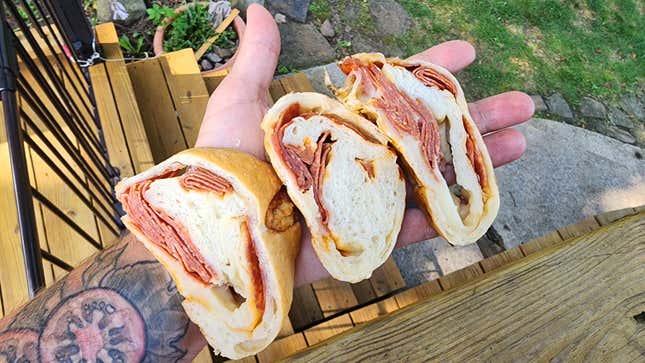
When it comes to quick and satisfying comfort food, handhelds reign supreme. Whether it’s a jelly doughnut, a bag full of empanadas, or a sausage-stuffed Texas kolache, the delicious convenience of doughy, stuffed foods can’t be overstated. But there’s one handheld giant that most people aren’t aware of, and I can only hope it becomes more widely embraced. It’s called a pepperoni roll, and it hails from West Virginia.
What is a pepperoni roll?
The pepperoni roll is simply a bread roll stuffed with pepperoni and cheese, then baked. Like most edible inventions, the emergence of the pepperoni roll is rife with foggy and inconclusive lore, though people tend to point toward Giuseppe Argiro, a Sicilian immigrant who worked in West Virginia coal mines. Stories say that when he opened a bakery in Fairmont, he remembered his coal miner friends eating a stick of salami in one hand and a hunk of bread in the other. “Combine the two! Duh!” goes the narrative. It’s one of the more unfounded food origin claims, right up there with the creation of the chimichanga, which is said to be the folly of a woman who serendipitously fumbled her burrito into a deep fryer.
Of course, there’s absolutely no way to corroborate Giuseppe’s eureka moment. But in the minds of some West Virginians, he had a Johnny Appleseed–like impact, spreading the good word of pepperoni-stuffed bread all throughout Appalachia. Others have a more conventional hypothesis: that the pepperoni roll came from the thrifty wives of coal miners who wanted their husbands to have portable, filling, shelf-stable lunches. Maybe I’m a romantic, but I choose to believe the story of matrimonial, working-class love.
Regardless of their origin, pepperoni rolls have endured in the area. So much so that they’re widely considered West Virginia’s state food. But, why haven’t they seen national success outside of the Mountain State? The highly portable pepperoni roll would do really well in a driving city like Los Angeles, but the delicacy has largely stuck to the Mid-Atlantic region, with notable exceptions including Western Pennsylvania and Eastern Ohio, where it’s been somewhat widely adopted. I tasted several pepperoni rolls around the area to get to the bottom of just why they’re so darn good, and what exactly the mass appeal is.
Why pepperoni rolls are so good
For starters, pepperoni rolls need no heating or refrigeration. In that way, they’re a lot like muffulettas, which sit wrapped in the open air at Central Grocer in New Orleans, awaiting purchase.
So much food is served piping hot or ice cold, but there’s something transcendently tasty—melt-in-your-mouth fatty, slick, and soft—about room-temp bread and deli meat. At many of the gas stations, bakeries, and food marts in West Virginia, the fresh pepperoni rolls are served in bags still filled with steam inside. Mind you, pepperoni rolls are still a time-sensitive meal meant to be consumed fresh, and that’s one of its strengths; chasing down a good pepperoni roll means waking up early, supporting your local bakers, and being entrenched in your community.
The ideal pepperoni roll has a rippable texture, soft and easily torn with your hands, not so dense that the bread becomes chewy. It’s more elegant than the name implies—the texture should always be that of freshly baked bread, maybe even a little more on the side of a freshly baked pastry.
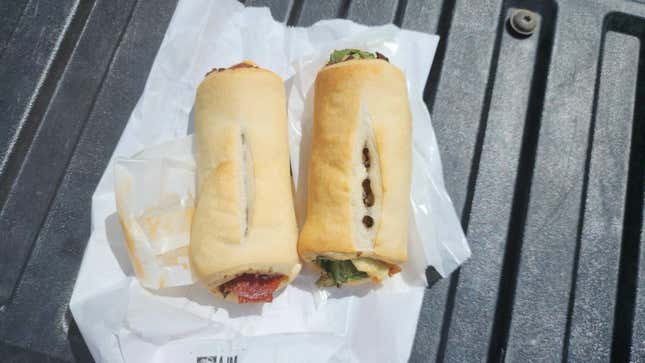
When you bake a soft Italian roll filled with pepperoni, the fat from the cured meat seeps into the bread itself. The bread absorbs the grease, staining parts of its interior bright red, offering alternating bites of pepperoni-filled, fat-stained Italian roll. Usually, these rolls also contain mozzarella cheese, but the amount of cheese varies. I’ve had many pepperoni rolls that contain very little. The cheese adds some creaminess, though it’s not entirely necessary. Sometimes a little bit of mozzarella seeps out and crisps up on the bottom of the roll while baking. That’s the roll you want.
Isn’t a pepperoni roll basically a calzone?
Not quite—the pepperoni contains only two ingredients, whereas calzones typically have more pizza fixings stuffed inside. However, some places, including Rolling Pepperoni near the Allegheny River in Pittsburgh, like to stretch the limits of what can be considered a pepperoni roll, using lots of other fillings to create a briny pepperoni roll with chopped olives, or a spicy iteration with pepperoncinis and pepperjack cheese. There are even a few vegan and vegetarian rolls, one of which features white wine simmered mushrooms, spinach, feta, and garlic.
As far as fillings go, Rolling Pepperoni takes the most liberties of all the establishments I’ve visited this summer. Most pepperoni rolls feature only pepperoni. Sometimes they contain pickled banana pepper or pepperoncini, like at RP, or this beauty at Apple Castle:
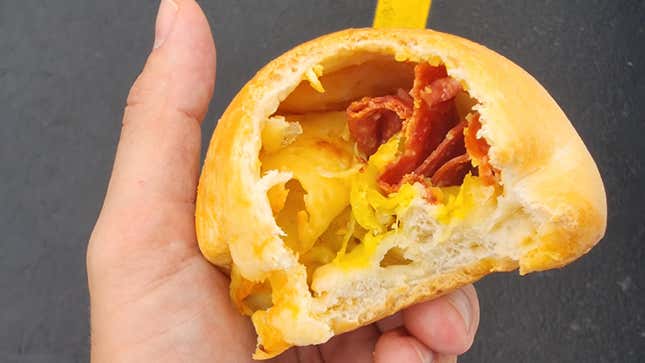
Calzones tend to have a more crescent shape (due to its approximation of a pizza folded over), while pepperoni rolls lean a bit more on the dinner roll side. Pepperoni rolls are usually a bit softer as well, whereas calzone dough runs thicker and breadier so as to hold in a range of pizza toppings. It really can be like splitting hairs, but the bottom line is that there shouldn’t be too much inside of a pepperoni roll besides pepperoni.
Pepoli’s is a brand from Huntington, West Virginia that sells pre-made, prepackaged rolls across a few different states. I picked up this one from Sheetz.
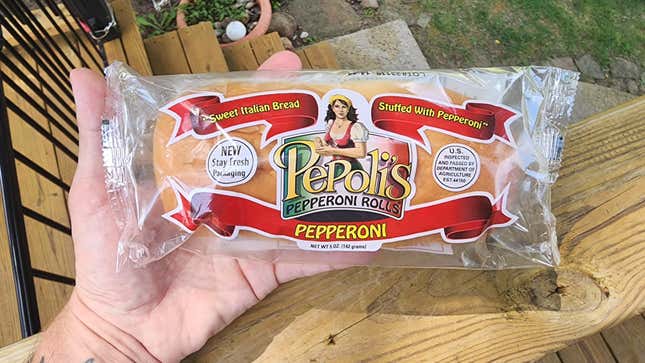
The quality of Pepoli’s isn’t very high, but the flavor is interesting, with a sweet, Hawaiian roll taste. The bread is super soft, too, and it’s absolutely stuffed with pepperoni. Definitely a good value buy, and something I could easily see on shelves at grocery stores across the country (but don’t).
The pepperoni roll from Pittsburgh bakery Mancini’s is truly great. It reads like a calzone thanks to its herby, buttery, garlicky flavor, and its exceptional bread features a semolina-dusted outer crust and soft interior. The rolls at Mancini’s come wrapped in foil and are kept in a large heat box labeled “Pepperoni Rolls.” You can get them with a side of sweet pizza sauce or ranch, though neither is all that necessary.
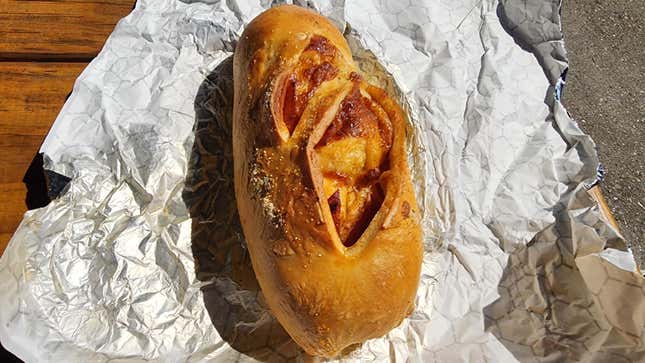
The best pepperoni roll I’ve had to date, though, comes from The Bread Chef in Youngstown, Ohio (in the photo at the top). This bread feels truly artisan, with a flavor that’s leagues beyond other pepperoni rolls, yeasty and fermented. It’s densely packed with high-quality, spicy pepperoni, none of that bagged Hormel that I assume mass-market brands are using.
Pittsburgh Post-Gazette food critic Hal B. Klein recommends the legendary Tomaro’s Bakery in Clarksville, West Virginia. That’s a bit of a haul for me, but I plan on visiting the pepperoni roll homeland before too long. Tomaro’s pepperoni rolls are also offered on Goldbelly, for those who are interested.
Pepperoni rolls should be everywhere
Despite the wealth of delicious pepperoni rolls throughout Appalachia, this style of freshly baked handheld meal has never spread to the rest of the country. For now, we’re limited to Papa Johns and the occasional pizzeria that uses its pizza dough to make a glorified Hot Pocket. It’s a shame, because it’s hard to imagine any community where they wouldn’t be embraced. Pepperoni rolls can be eaten on the go, whether you’re walking, driving, biking, or taking public transit: no sauce, barely any crumbs, and a ton of sustenance.
Everyone deserves to experience what happens when pepperoni cooks inside of a soft Italian roll, its fat seeping into the crumb alongside some gooey melted mozzarella. The pepperoni roll is a triumph of the bakeries that make them and the communities in which they thrive. The question is, are there enough bakers with a love and appreciation for Appalachian cooking to spread the good word nationwide?